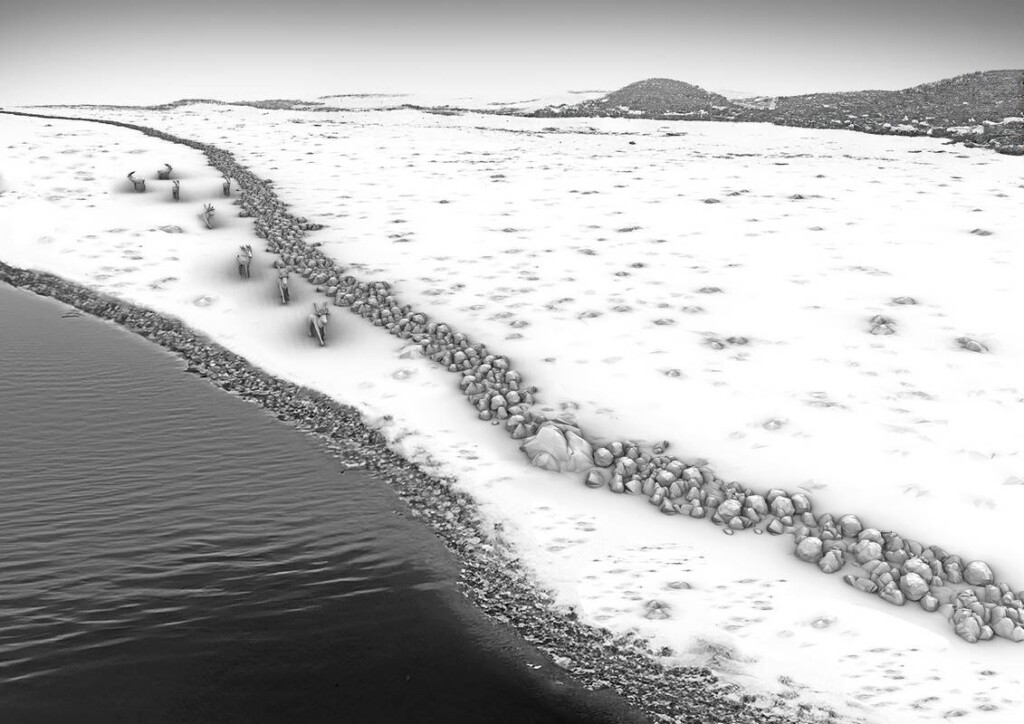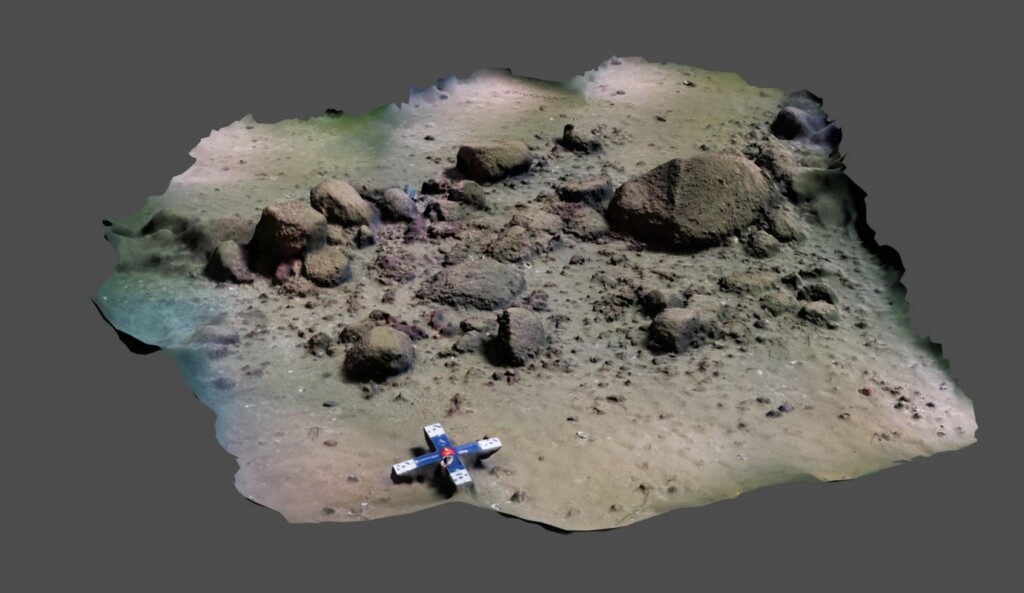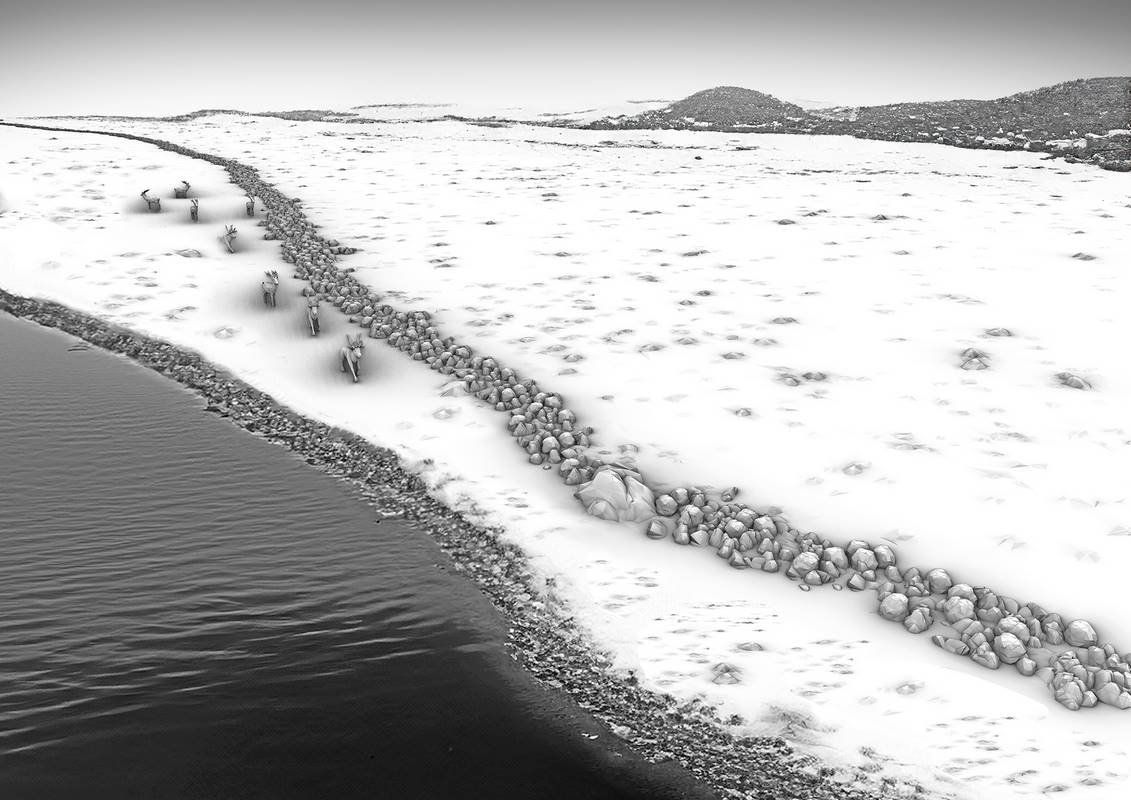
In the autumn of 2021, geologists discovered an unusual row of stones, more than half a mile long, just 21 meters below the sea off the Baltic coast.
The approximately 1,500 stones are aligned so regularly that a natural origin seems unlikely. A team of researchers from different disciplines now concluded that Stone Age hunter-gatherers likely built this structure around 11,000 years ago to hunt reindeer.
The finding represents the first discovery of a Stone Age hunting structure in the Baltic Sea region. The scientists now present their findings in the Proceedings of the National Academy of Sciences (PNAS).
Originally, a team of researchers and students from Kiel University (CAU) wanted to investigate manganese crusts on a ridge of basal till that forms the seafloor about 6 miles off the coast of the Pomeranian town of Rerik.
During their survey, however, they stumbled upon this strange row of stones characterized by many smaller stones that connect several large boulders. The researchers reported their discovery to the Mecklenburg-Vorpommern State Agency for Culture and Monument Preservation.
Today, the Baltic Sea is around 68 feet (21 meters) deep at this location. Thus, the stone wall must have been built before the sea level rose significantly after the end of the last ice age, which happened for the last time around 8,500 years ago. Large parts of the previously accessible landscape ultimately flooded at that time, but beforehand, the end of the wall likely touched a bog or lake; as can be seen in the basin-shaped depression underwater.
For German readers, a more complex study was carried out by the Leibniz Institute for Baltic Sea Research Warnemünde (IOW), the research priority area at Kiel Marine Science at Kiel University, the University of Rostock, the Centre for Baltic and Scandinavian Archaeology (ZBSA, since 2024 part of the Leibniz Centre for Archaeology LEIZA), the German Aerospace Center (DLR), the Alfred Wegener Institute, Helmholtz Centre for Polar and Marine Research (AWI) as well as the LAKD M-V.
MORE FINDS UNDER SHALLOW SEAS: 7,000-year-old Road Uncovered in Croatia is Paved in Stone–A ‘Sensational Find’
This multi-disciplinary team used modern geophysical methods to create a detailed 3D model of the wall and to reconstruct the structure of the ancient landscape. Using sediment samples from the adjacent basin to the south, it was possible to narrow down the period when the wall could have been built. Furthermore, research divers from the universities of Rostock and Kiel explored the stone wall.
“Our investigations indicate that a natural origin of the underwater stone wall as well as a construction in modern times, for instance in connection with submarine cable laying or stone harvesting, is not very likely,” explains Jacob Geersen, lead author of the study. “The methodical arrangement of the many small stones that connect the large, non-moveable boulders, speaks against this.”
Excluding natural processes and a modern origin, the stone wall could only have been formed after the end of the last ice age, when the landscape was not yet flooded by the Baltic Sea.

“At this time, the entire population across northern Europe was likely below 5,000 people. One of their main food sources were herds of reindeer, which migrated seasonally through the sparsely vegetated post-glacial landscape,” said Marcel Bradtmöller from the University of Rostock.
“The wall was probably used to guide the reindeer into a bottleneck between the adjacent lakeshore and the wall, or even into the lake, where the Stone Age hunters could kill them more easily with their weapons.”
STONE AGE DISCOVERIES: Scotland Claims it’s Found 5,000 Year Old Monument on ‘par with Stonehenge’ on the Isle of Arran
Such tactics would have been important, since it takes tremendous skill and physical power to throw something like a wooden spear at a large animal like a reindeer and actually wound it.
Comparable prehistoric hunting structures have already been found in other parts of the world, for example at the bottom of Lake Huron (Michigan) at a depth of 30 meters. Here, US archaeologists documented stone walls as well as hunting blinds constructed for hunting caribou, the North American equivalent of reindeer. The stone walls in Lake Huron and in Rerik share many characteristics such as a location on the flank of a topographic ridge, as well as a subparallel trending lakeshore on one side.
As the last reindeer herds disappeared from our latitudes around 11,000 years ago, when the climate became warmer and forests were spreading, the stone wall was most likely not built after this time. This would make it the oldest human structure ever discovered in the Baltic Sea.
YOU MIGHT ALSO LIKE: Bison Herd New to Park Uncover Ancient Petroglyphs With Their Hooves Fulfilling Indigenous Prophecy
“Although numerous well-preserved archaeological sites from the Stone Age are known from the Bay of Wismar and along the coast of Mecklenburg-Vorpommern, these are located in much shallower water depths and mostly date to the Mesolithic and Neolithic periods (approx. 7,000 – 2,500 BCE),” explains Jens Auer from the Mecklenburg-Vorpommern State Office for Culture and Monument Preservation (LAKD M-V), who was involved in the exploration and sampling of many of these sites.
The stone wall and the surrounding seabed will be investigated in more detail using side-scan sonar, sediment echo sounder, and multibeam echo sounder devices. Additionally, research divers from the University of Rostock and archaeologists from the LAKD M-V are planning further diving campaigns to search the stone wall and its surroundings for archaeological finds that could help with the interpretation of the structure.
Luminescence dating, which can be used to determine when the surface of a stone was last exposed to sunlight, may help to get a more precise date of when the stone wall was constructed. Furthermore, the researchers intend to reconstruct the ancient surrounding landscape in more detail.
SHARE This Fascinating Discovery With Your Friends On Social Media…




















